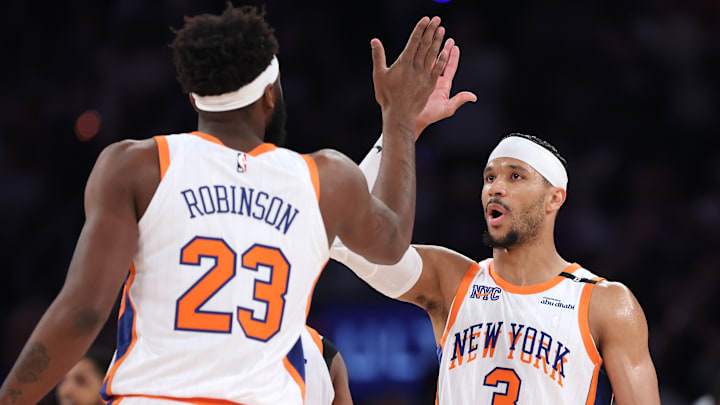If the New York Knicks are going to implement more five-out basketball into their offense, they’ll need Josh Hart and Mitchell Robinson to coexist in separate units. Given the limitations of both on the more glamorous end, this is not a given.
Staggering Robinson and Hart, in fact, is among the biggest arguments for starting Mitch rather than running five-out from the jump with Deuce McBride. The two are not an intuitive pair on offense. Defenses don’t need to guard Robinson too high up the floor, and they won’t care about sagging off Hart or going under him on screens.
Still, New York cannot hope to avoid playing them together—not without severely limiting the amount of time they get to roll with five floor-spacers.
Returns on Josh Hart-Mitchell Robinson minutes are mixed
Last year, the Knicks played 186 regular-season minutes with both Hart and Robinson on the court. During this time, they posted a slightly positive net rating (plus-0.14), while scoring a very middle-of-the-pack 1.15 points per possession.
Then, however, the playoffs rolled around. Hart and Robinson crushed it together. Over an additional 182 minutes, New York outscored opponents by over 10.9 points per 100 possessions, with an offensive rating that would have placed second for the entire postseason.
Exploiting teams on the offensive glass was the key. The Knicks were among the most high-volume and efficient second-chance teams in the playoffs during these stretches. They shot 45.8 percent on threes after grabbing an offensive rebound, and only the Cleveland Cavaliers generated more second chances per 100 possessions.
It wasn’t all sunshine and daisies, though. Hart’s shot profile got warped during his stints alongside Robinson. Across both the regular season and playoffs, 46.5 percent of Hart’s shot attempts came at the rim without Robinson on the floor. That number plunged down to 24.5 percent when the two played tougher. New York’s first-chance offensive rating also suffered a big hit.
The Knicks need this duo to work
This is all to say: Offensive success is not a given for the Hart-and-Robinson minutes. The Knicks can insulate them by ensuring one or both of Jalen Brunson and Karl-Anthony Towns are on the floor, but the spacing could get wonky even with three other above-average shooters on the court.
New York needs to explore this grouping anyway. Mike Brown can’t get to five-shooter lineups for stretches without navigating different looks during others.
Fortunately for the Knicks, the Hart and Robinson dyad has the chops to muck things up on defense—particularly when OG Anunoby is alongside them. Opponent three-point shooting may have been a little fluky (33.1 percent for the year), but they are guaranteed to control the glass, and their scoring on second-chance opportunities will give their defense additional time to get set.
Brown can also game it so New York only fields this duo versus other bench units. Those lineups are typically easier to defend, and oftentimes smaller, making it easier to clean up your own misses.
If the Hart-Robinson dynamic doesn’t pan out, the Knicks can recalibrate their approach at that time. But they have to at least give it a try. It’s the only way they can play all of their best players and deploy the five-out lineups that can render them unguardable.
